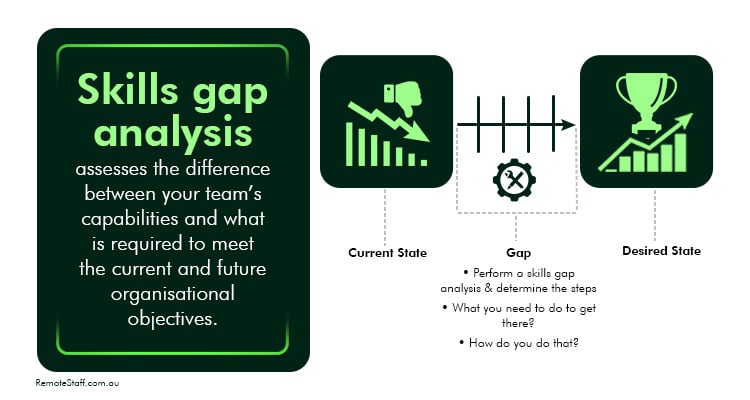Many companies today are increasingly concerned about how to address the sudden skill gaps in their workforce.
Skill gaps refer to the void between industry skill requirements and the actual skills applicants and employees possess.

These gaps are a key factor in labor shortages worldwide, particularly the recent accountant shortage in Australia. According to one study, skill gaps cost companies one million dollars (USD) yearly.
To help you overcome this challenge, here are some strategies to identify and address skill gaps in your team.
What Causes Skill Gaps?
There are several factors contributing to the increase in skill gaps today. These are:
- Advances in Technology: Rapid technological progress, especially in artificial intelligence (AI), often outpaces the typical worker’s ability to adapt, leading to the shortages of necessary technical skills.
- Educational Shortcomings: Sometimes, traditional education fails to equip graduates with practical skills for today’s job market.
- Changing Industry Demands: As industries evolve, new roles will emerge that require a different skill set than the ones currently in existence.
- Aging Workforce: As more experienced workers retire, it gets more challenging to find young workers with the necessary skills and experience to replace them with.
How to Identify Skill Gaps in Your Team
Before you can address the skill gaps in your team, you must first identify which skills they currently lack. The best way to do so is by conducting a skills gap analysis.
A skills gap analysis assesses the difference between your team’s capabilities and what is required to meet the current and future organisational objectives. It helps you plan the right training and support to make your employees more effective at work.

How to Conduct a Skills Gap Analysis
There are three steps to conducting a skills gap analysis:
- Define Your Objectives and Identify Key Skills
- Identify your objective for conducting the skills gap analysis. Is it to address immediate skill shortages? To prepare for future openings?
- Next, identify the skills your team needs to achieve your business goals. These include technical (data entry, programming, software development) and soft skills (critical thinking, leadership, communication).
- Gather Data for Analysis
- Once you’ve identified the skills vital to your business, it’s time to assess your team’s current proficiency. This can be done via performance reviews, skill tests, and managerial feedback.
- Measure their performance with established Key Performance Indicators (KPIs) to help identify areas where employees lack the necessary skills to meet job requirements.
- Determine which skill gap to prioritize by measuring their impact on your business’s goals and operations.
- Develop an Action Plan
- After identifying which skill gaps to prioritize, create a detailed action plan to address them.
- Provide the necessary training and support for your employees. Continuously monitor their progress and make adjustments to your plan as needed.
Strategies for Closing Skill Gaps
After determining the skill gaps within your team, here are ways to address them:
Promote Lifelong Learning
Encourage your team to continuously hone their skills and learn new ones by investing in their training and development.

This includes providing in-house training programs, workshops, online courses, and certification programs. Additionally, give them opportunities to apply what they’ve learned and celebrate their successes.
Doing so helps them keep pace with advances in their fields and boosts employee trust and morale.
Implement Mentorship Programs
One way to pass down your senior employees’ experience to more junior members is by pairing them up in mentorship programs.
This helps provide hands-on learning opportunities for newer employees and fosters a supportive learning environment for them.
Work With -Not Against- AI
Contrary to what some fear, AI won’t fully replace humans in their jobs. Instead, it will help them be more productive.
Use AI to help predict future skill needs based on trends and business goals and then set training initiatives accordingly.
Additionally, AI can also recommend personalized learning paths for employees based on their current skills and progress.
Recruit Strategically
When hiring new employees, don’t just focus on the skills you need now, but also on potential requirements based on your company’s goals and industry trends.
Look for candidates with a strong eagerness to learn. Offer a clear and straightforward onboarding process to them so they can quickly acclimate themselves to your company.
Outsource Your Business Needs
An increasingly popular way for many businesses to gain access to specialized skills is by outsourcing them to professionals from countries like the Philippines.
Not only is it a quick solution to skill gaps, but it also helps you avoid the overhead cost of hiring their in-house counterpart.
Aside from roles like virtual assistants and admin assistants, many AU companies also outsource their accounting and human resources needs to remote contractors.
Bridging the Gap Between Employees and Their Roles
Career gaps, if left unresolved, greatly diminish your team’s productivity and slow down your business growth.
Fortunately, by following the tips above, you can better address the skill gaps within your team and propel your business to newer heights.
Considering outsourcing to the Philippines to help you close your team’s skill gaps? Click here to see our full list of candidates. Good luck!
John Carlo Pagsolingan is a carefree yet hardworking writer with aspirations of becoming a teacher in the future. He believes that remote working isn’t just a substitute; but is a legitimate alternative to face-to-face work. Learn more as he writes about the advantages of remote work and tips for aspiring remote workers.





















